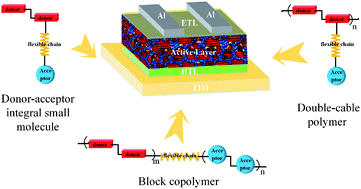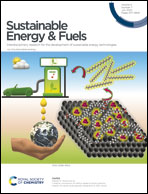Self-assembled bulk heterojunctions from integral molecules with nonconjugately linked donor and acceptor units for photovoltaic applications
Abstract
A bicontinuous interpenetrating donor–acceptor network with a suitable phase-separated domain size is crucial for fabricating highly efficient organic bulk heterojunction solar cells considering the fact that it guarantees effective exciton dissociation and smooth charge transport. For traditional binary blend bulk heterojunctions, the photoactive layer is a simple physical mixture of the donor and acceptor; further, the size of phase separation is primarily determined by the aggregation characteristics of the donor and acceptor. Moreover, it is difficult to control and stabilize it. To resolve this problem, a kind of donor–acceptor integral molecule in which the donor and acceptor units are linked by nonconjugated flexible linking units has been proposed. The energy levels and absorption spectra of the integral molecules can be easily controlled by tuning the donor and acceptor units. Furthermore, these integral molecules can form a microphase-separated bulk heterojunction of the donor and acceptor phases via a self-assembly process of the molecule, which is governed by the flexible linking unit responsible for connecting the donor and acceptor units. Since the donor and acceptor units of the integral molecules are connected by nonconjugated units, the scale of aggregation and morphological stability can be easily controlled. In this review, we first introduce the unique characteristics of three typical donor–acceptor integral molecules and then highlight their current developments. For each donor–acceptor molecule, we attempt to give a detailed summary with regard to their design and synthesis, and an in-depth understanding on the basic mechanism of molecular self-assembly and the performance comparison of SMSCs. In the end, the prospect and potential improvements in the donor–acceptor integral molecule are addressed. We believe that emerging donor–acceptor molecules can provide worthwhile opportunities for the fabrication of efficient and stable organic solar cells.

- This article is part of the themed collection: Sustainable Energy and Fuels Recent Review Articles


 Please wait while we load your content...
Please wait while we load your content...